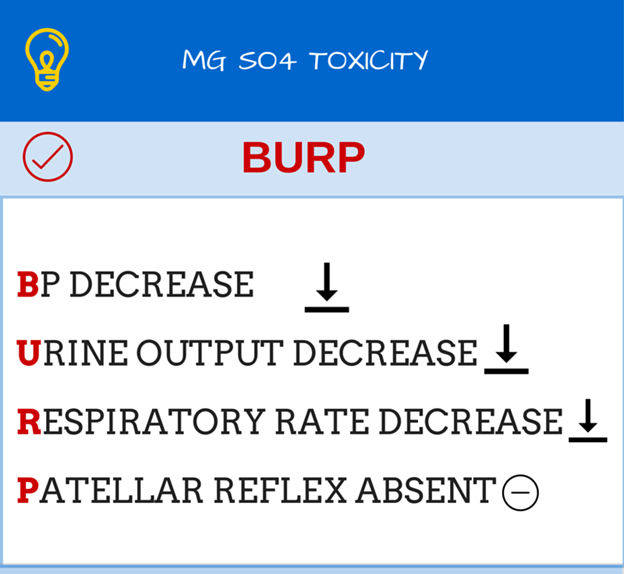A nurse is preparing to administer hydralazine to a client with severe pre-eclampsia who has a blood pressure of 170/110 mmHg.
What is the expected outcome of this medication?
To prevent seizures
To lower blood pressure
To increase urine output
To improve placental perfusion
The Correct Answer is B
To lower blood pressure. Hydralazine is an antihypertensive drug that is used to treat severe hypertension in pre-eclampsia. It works by relaxing the blood vessels and reducing the resistance to blood flow.
This helps to lower the blood pressure and prevent complications such as stroke, kidney damage, or placental abruption.
Choice A is wrong because hydralazine does not prevent seizures.
Seizures are a symptom of eclampsia, a more severe form of pre-eclampsia. To prevent seizures, magnesium sulfate is usually given intravenously.
Choice C is wrong because hydralazine does not increase urine output. In fact, it may cause fluid retention and edema as a side effect. Diuretics are drugs that increase urine output, but they are not recommended for pre-eclampsia because they may worsen the condition by reducing blood volume and placental perfusion.
Choice D is wrong because hydralazine does not improve placental perfusion.
Placental perfusion is the blood flow to the placenta, which provides oxygen and nutrients to the fetus.
Placental perfusion may be impaired in pre-eclampsia due to abnormal development of the placental blood vessels. Hydralazine does not affect the placental blood vessels directly, but it may improve placental perfusion indirectly by lowering the maternal blood pressure and reducing the risk of abruption.
However, this is not the primary or expected outcome of hydralazine therapy.
Nursing Test Bank
Naxlex Comprehensive Predictor Exams
Related Questions
Correct Answer is A
Explanation
A. Urinary output of 25 mL/hour.This indicates magnesium toxicity and requires immediate intervention because it means the kidneys are not functioning properly and magnesium is not being excreted.Magnesium toxicity can cause life-threatening complications such as respiratory depression, cardiac arrest, and coma.
B. Respiratory rate of 14 breaths/minute is normal and does not indicate magnesium toxicity.A respiratory rate of less than 12 breaths/minute or more than 20 breaths/minute would be abnormal and require further assessment.
C. Deep tendon reflexes 1+ are normal and do not indicate magnesium toxicity.A loss of deep tendon reflexes or clonus would indicate magnesium toxicity and require immediate intervention.
D. Serum magnesium level of 6 mg/dL is within the therapeutic range for preeclampsia and does not indicate magnesium toxicity.
The therapeutic range for preeclampsia is 4 to 7 mg/dL.A serum magnesium level of more than 8 mg/dL would indicate magnesium toxicity and require immediate intervention.

Correct Answer is C
Explanation
Magnesium sulfate.Magnesium sulfate is thedrug of choiceto prevent and treat seizures in people with severe preeclampsia and eclampsia.It is an anticonvulsant medication that reduces the risk of eclampsia by 50%.
Choice A is wrong because hydralazine is a blood pressure medication that can lower blood pressure in people with preeclampsia or eclampsia, but it does not prevent seizures.
Choice B is wrong because nifedipine is another blood pressure medication that can lower blood pressure in people with preeclampsia or eclampsia, but it does not prevent seizures.
Choice D is wrong because diazepam is an anticonvulsant medication that was previously used to treat eclamptic seizures, but it has been replaced by magnesium sulfate as the preferred drug due to its better safety and efficacy.Diazepam can also cause sedation and respiratory depression in the mother and the fetus.
Normal ranges for blood pressure are below 140/90 mm Hg, for proteinuria are below 300 mg/24 hours, for platelet count are 150,000 to 450,000 per microliter, for liver enzymes are 7 to 56 units per liter for alanine aminotransferase (ALT) and 10 to 40 units per liter for aspartate aminotransferase (AST), and for magnesium levels are 1.5 to 2.5 mEq/L.
Whether you are a student looking to ace your exams or a practicing nurse seeking to enhance your expertise , our nursing education contents will empower you with the confidence and competence to make a difference in the lives of patients and become a respected leader in the healthcare field.
Visit Naxlex, invest in your future and unlock endless possibilities with our unparalleled nursing education contents today
Report Wrong Answer on the Current Question
Do you disagree with the answer? If yes, what is your expected answer? Explain.
Kindly be descriptive with the issue you are facing.
